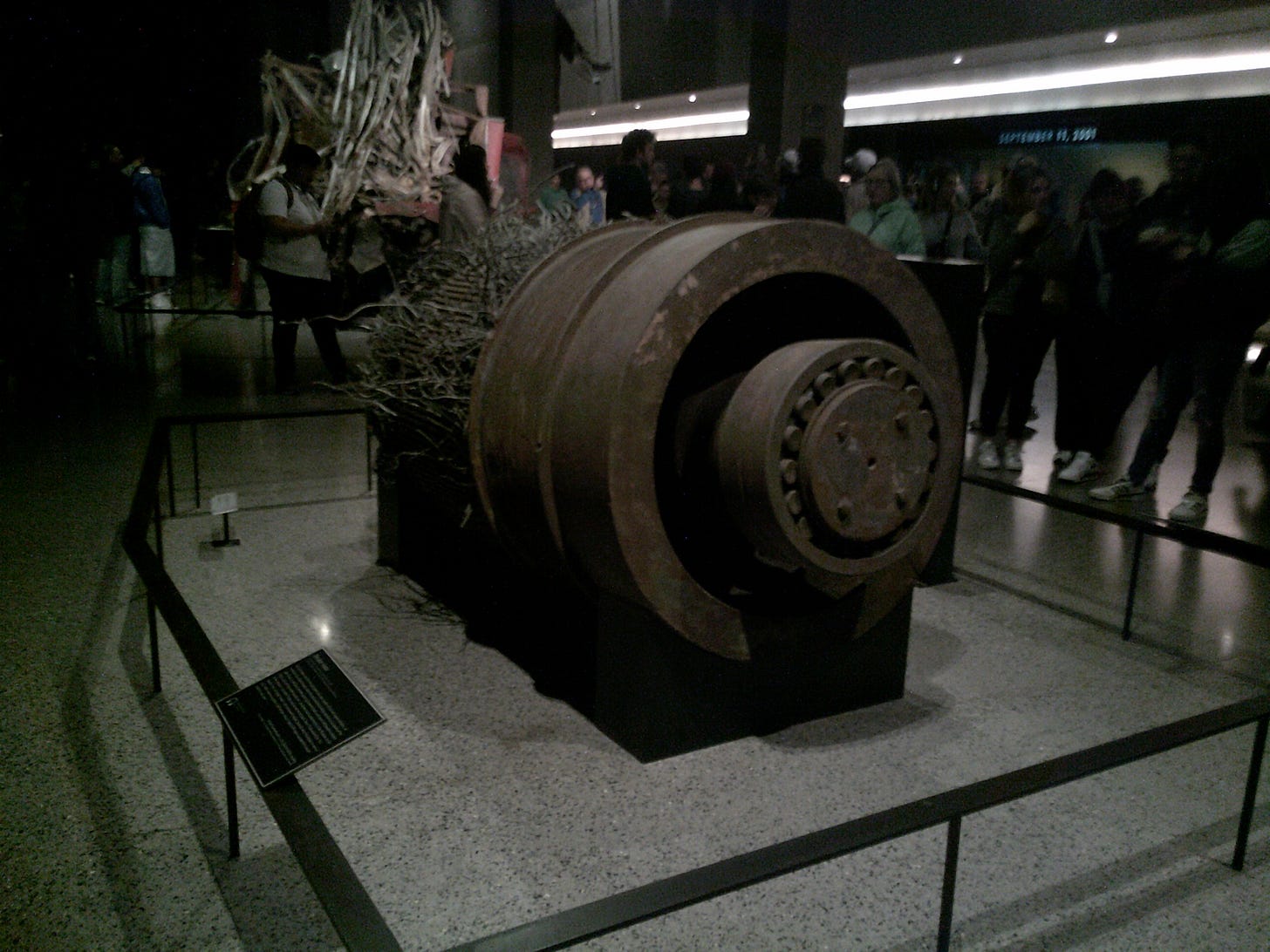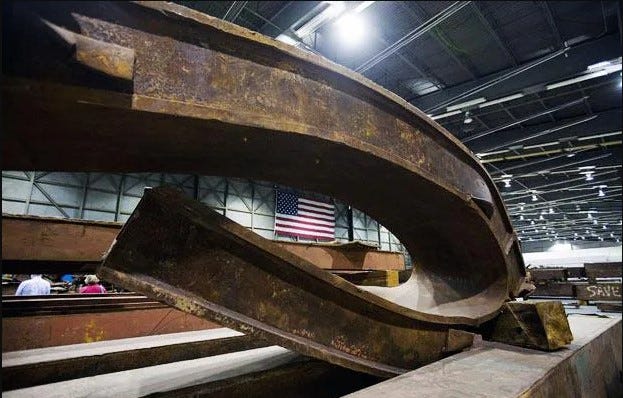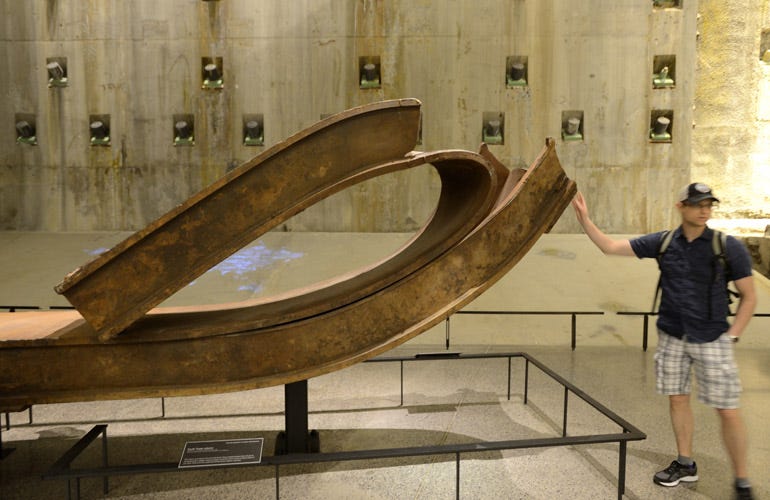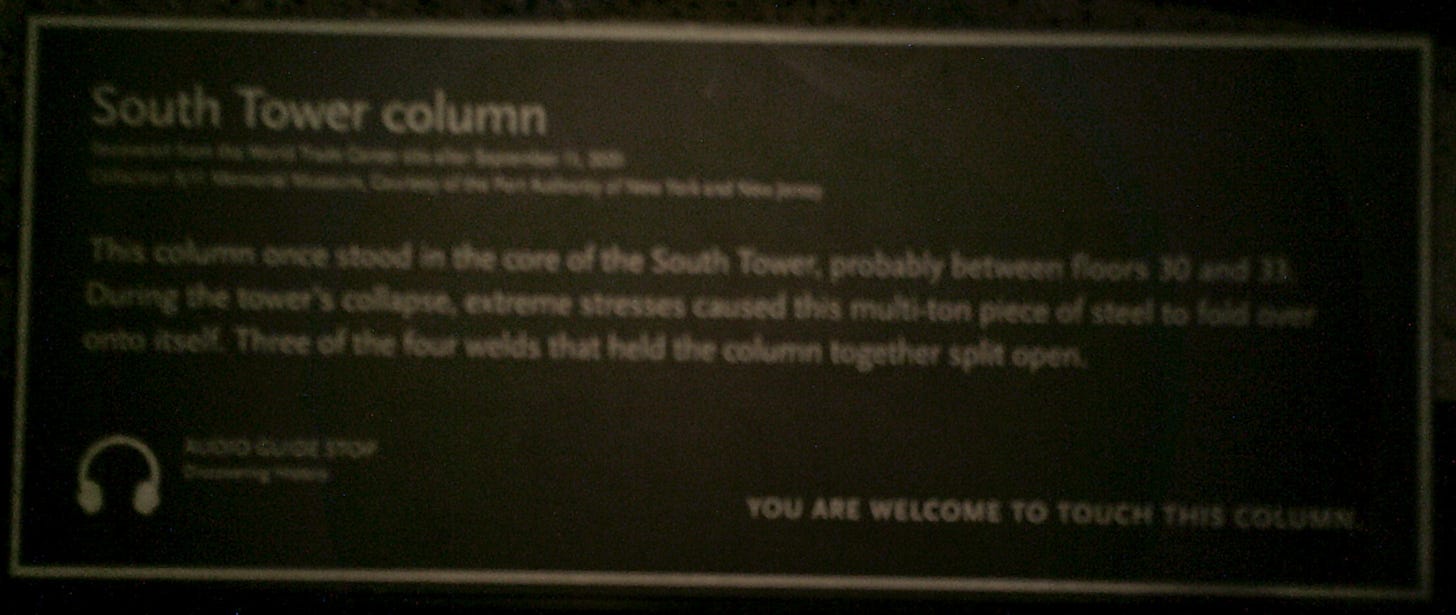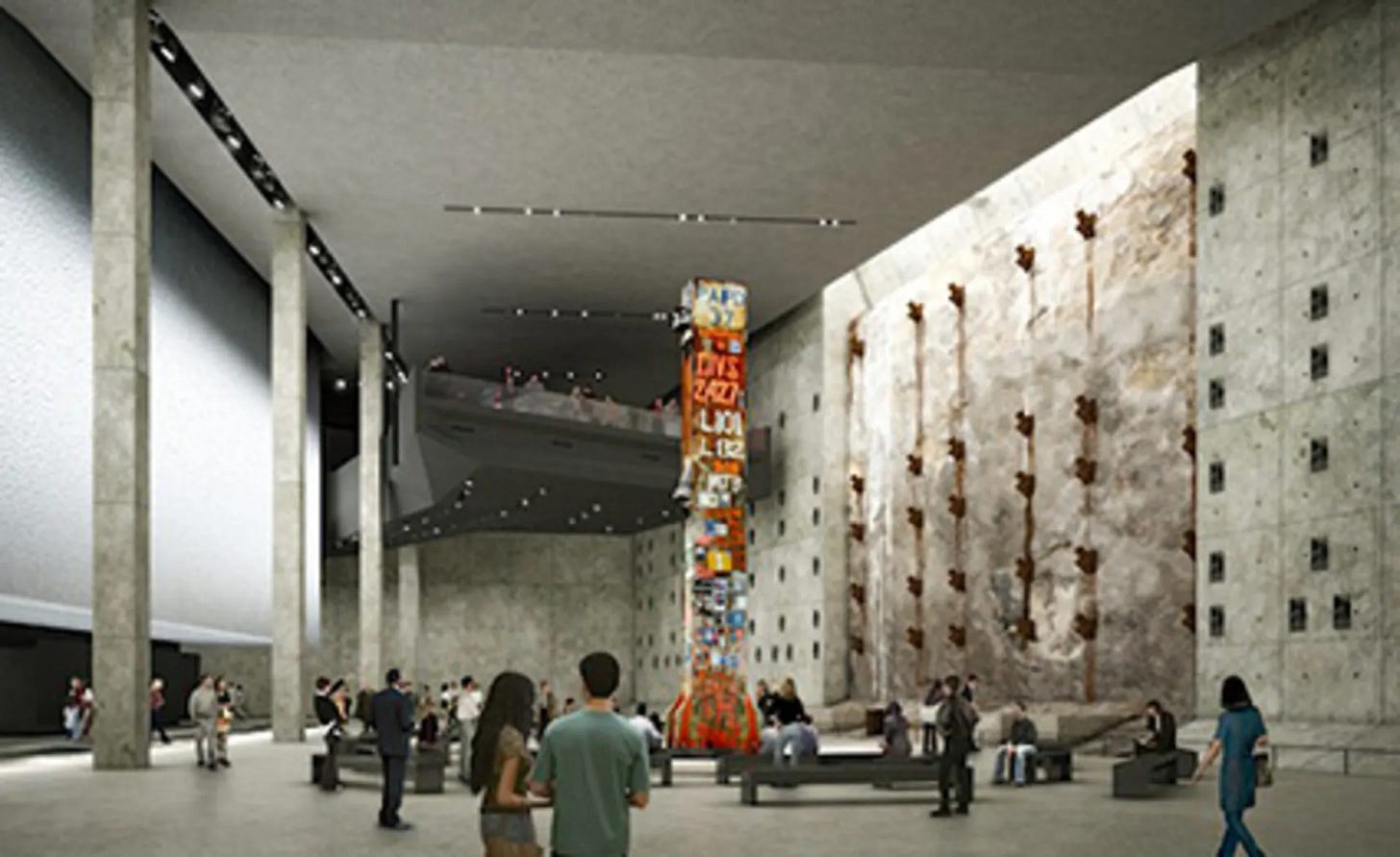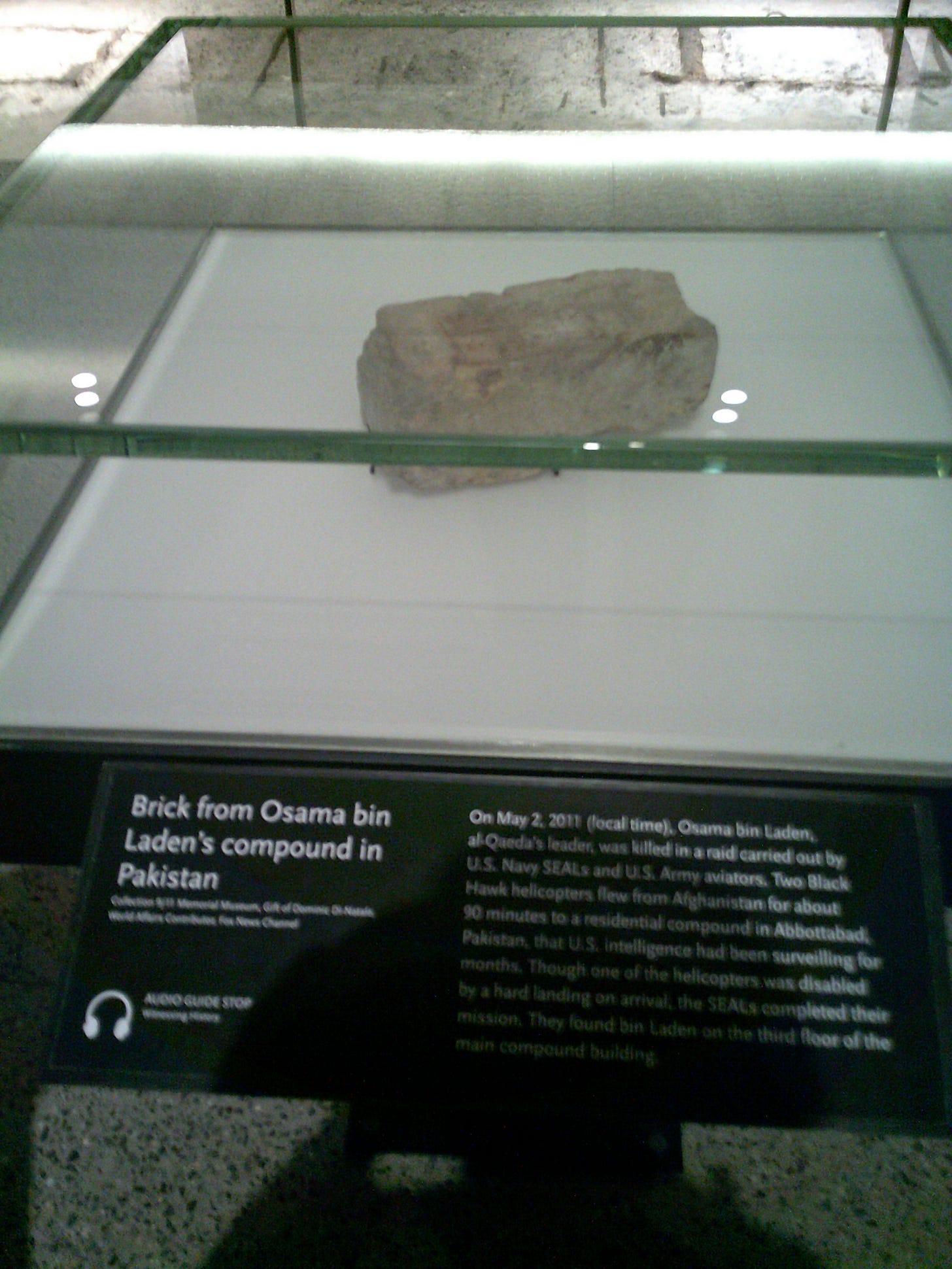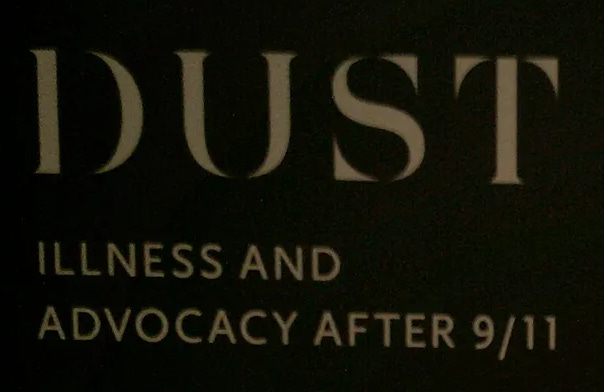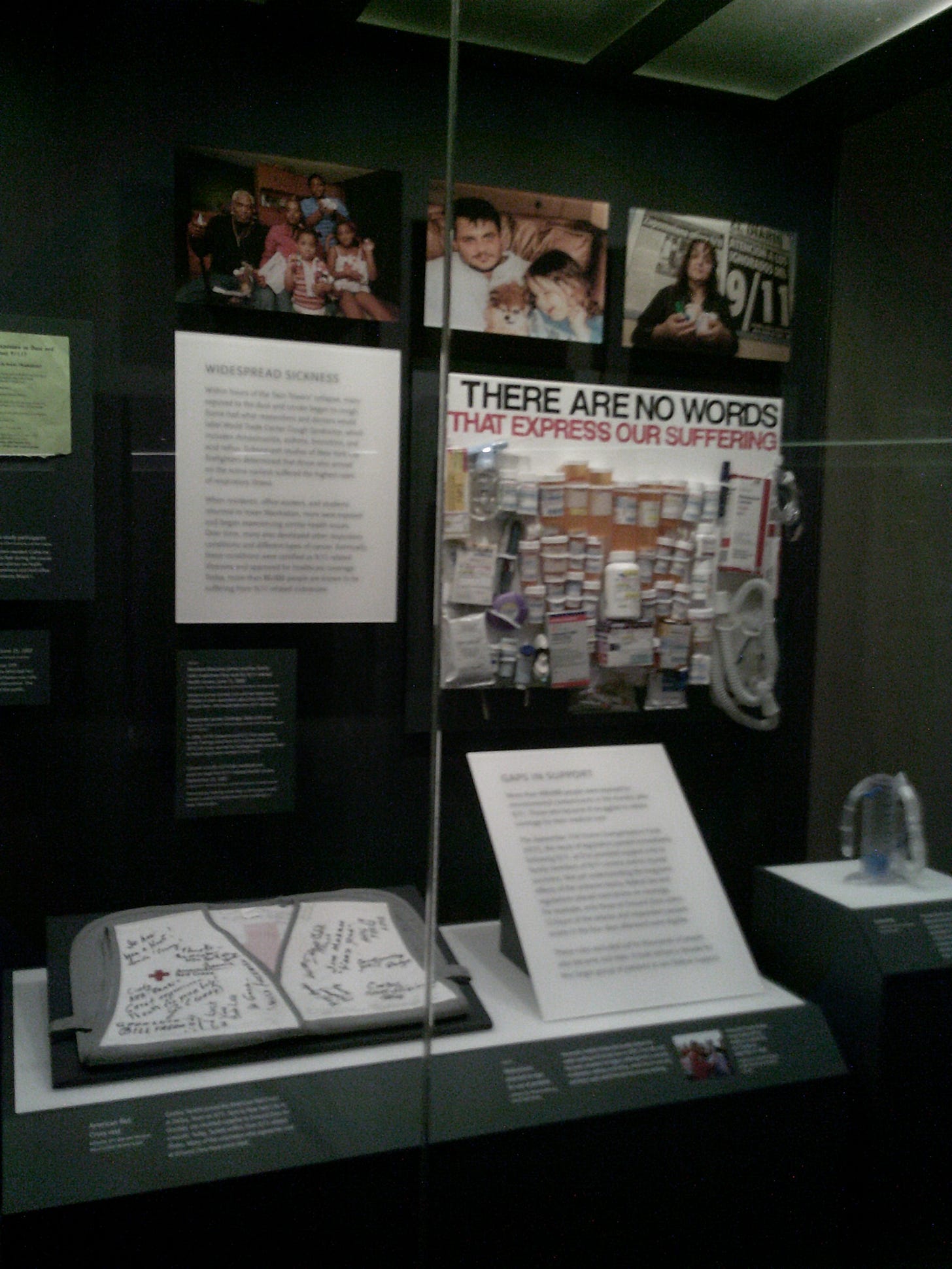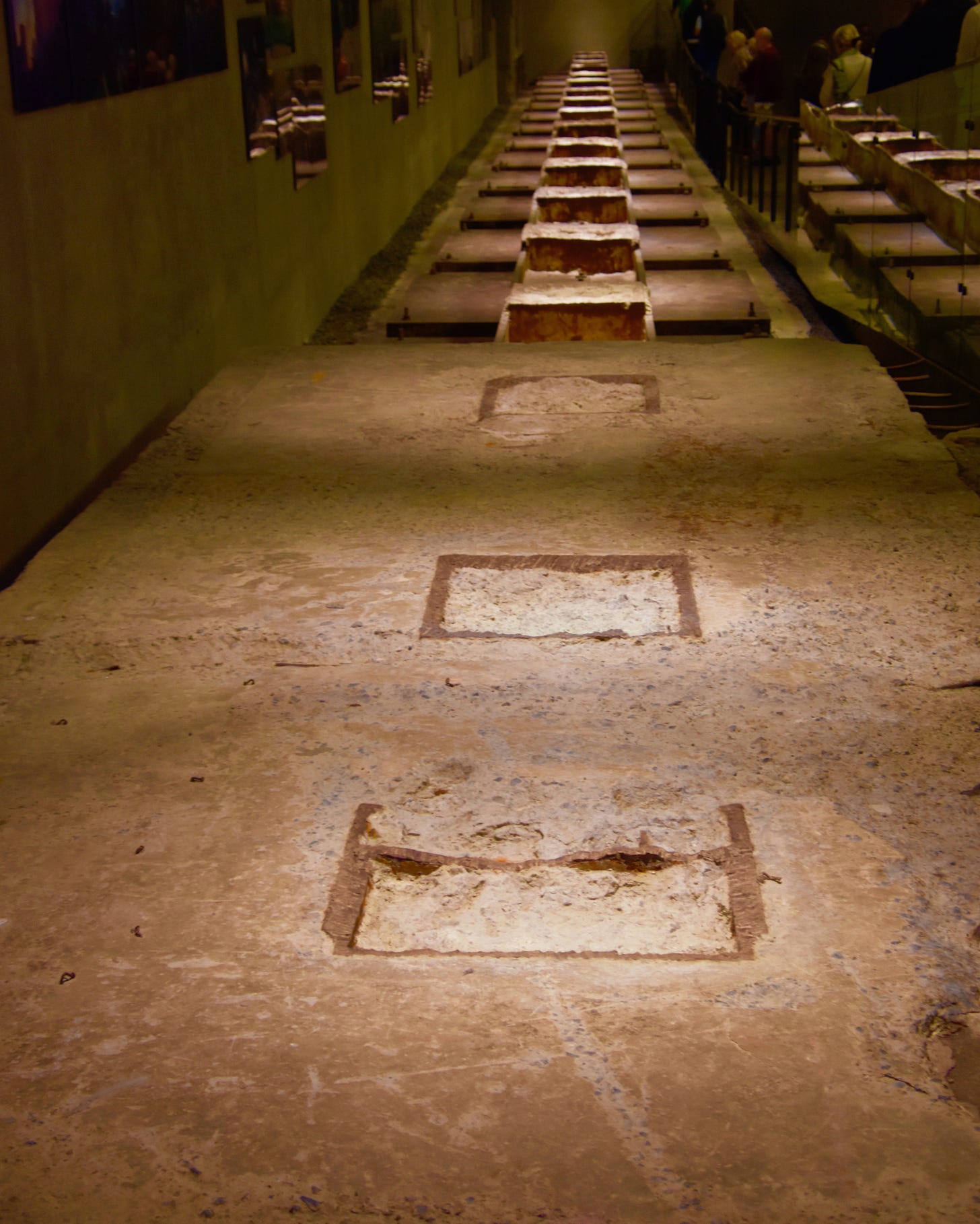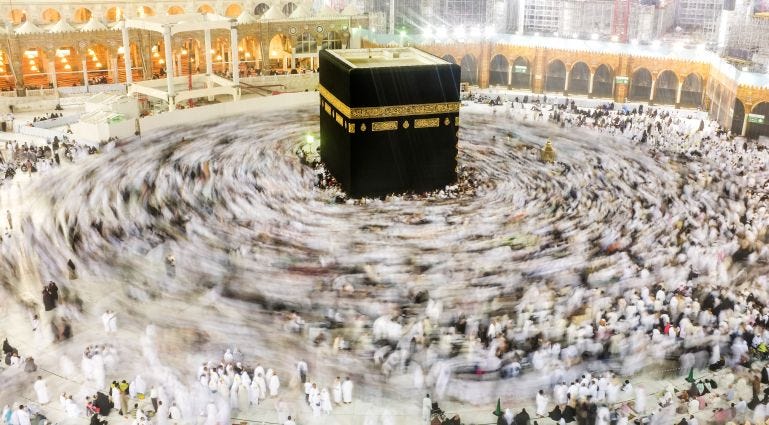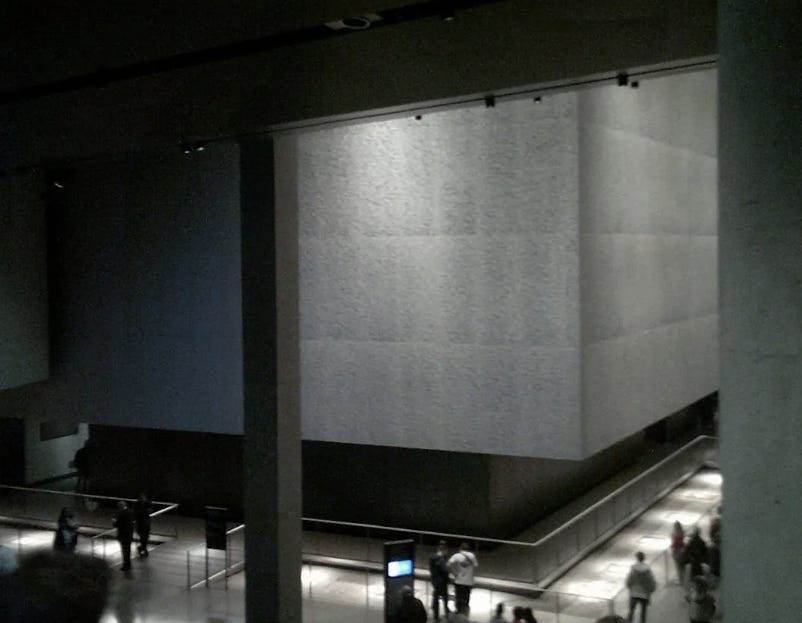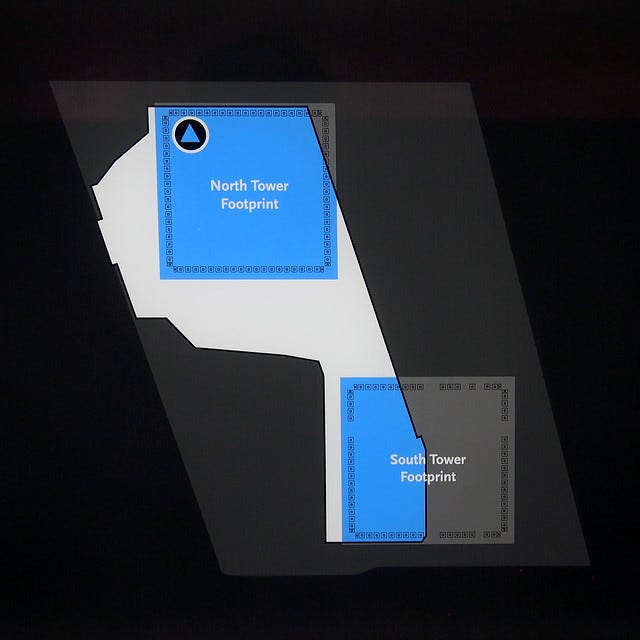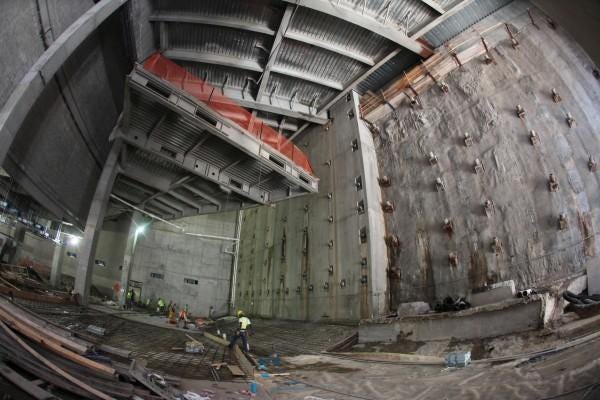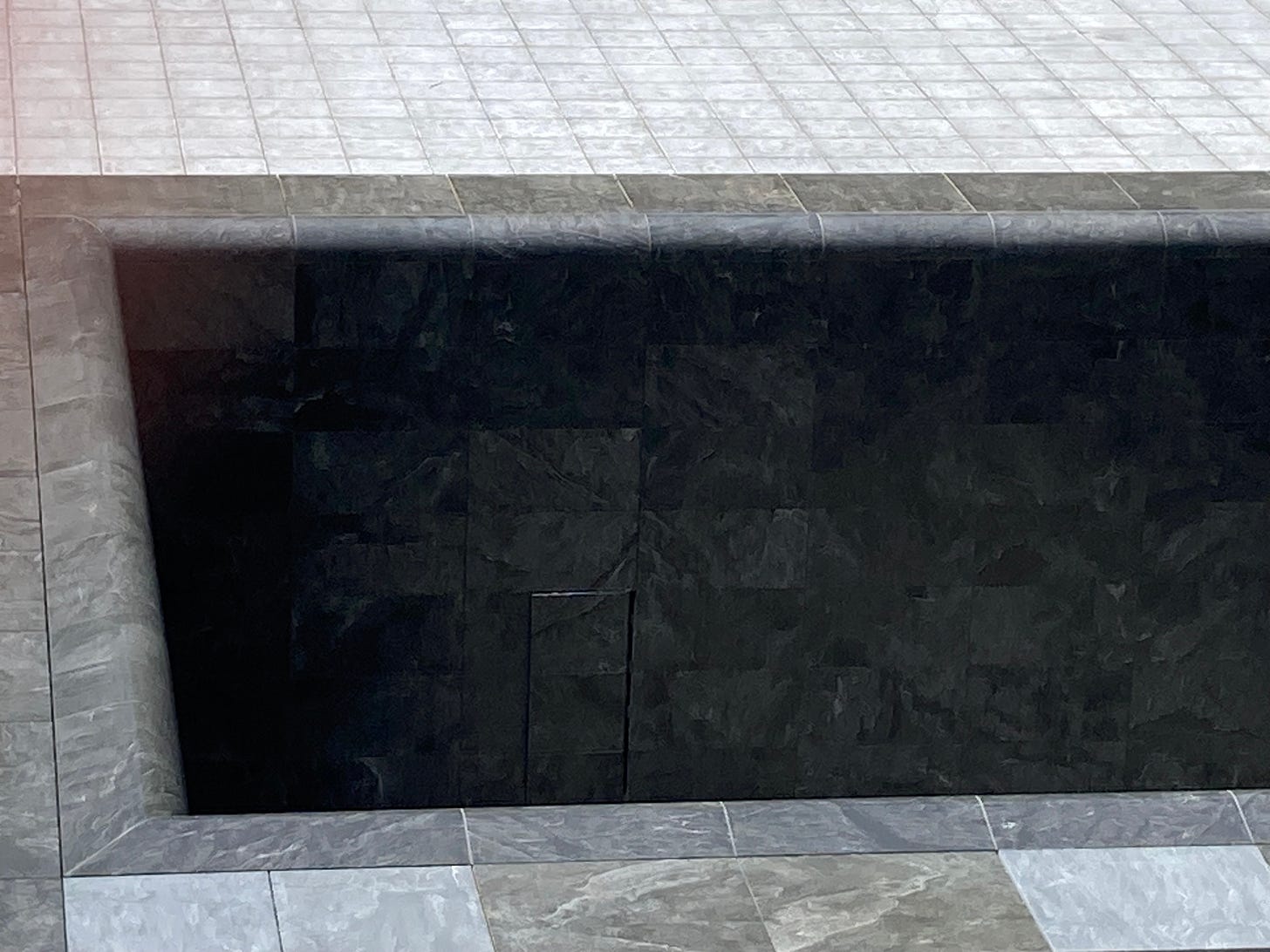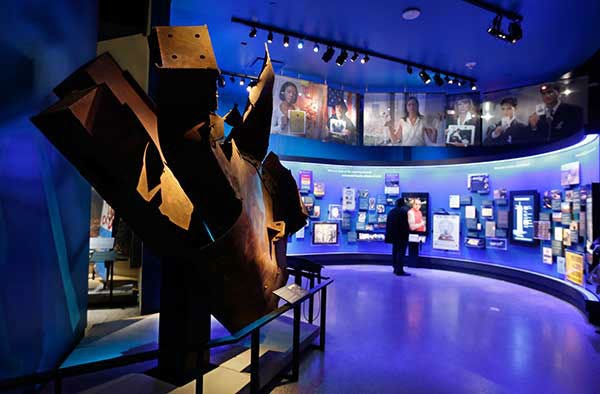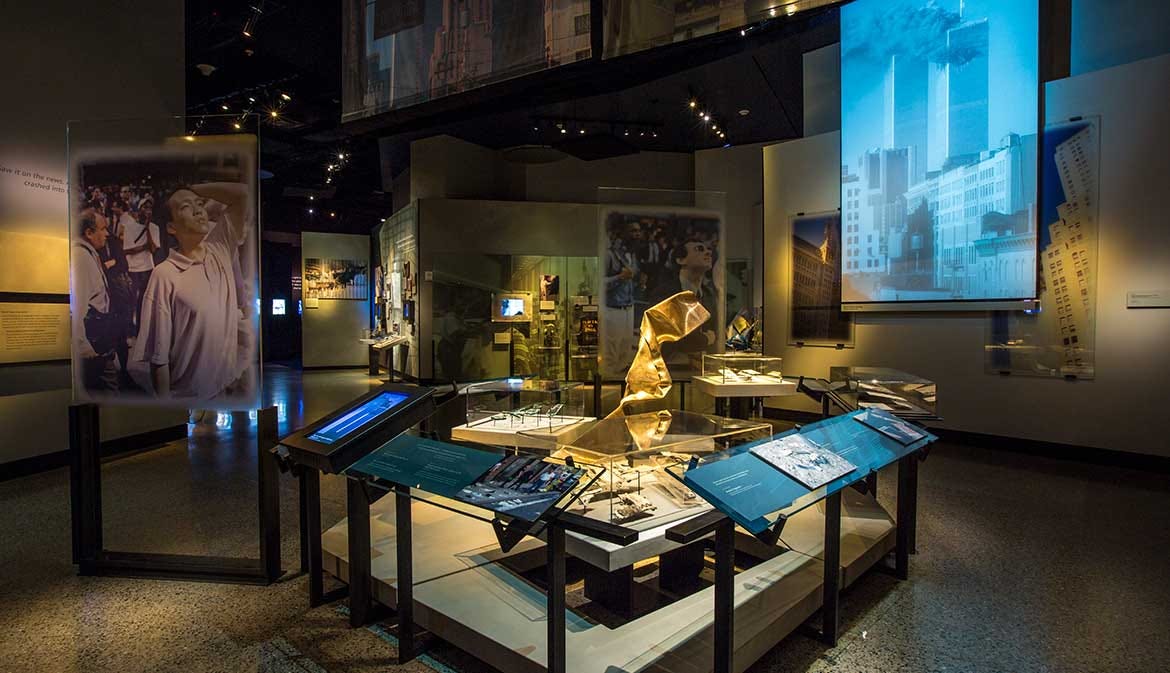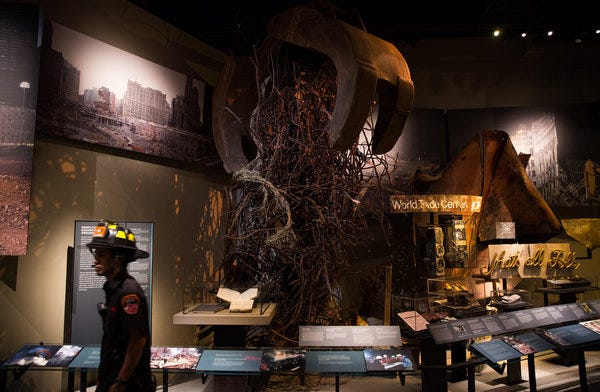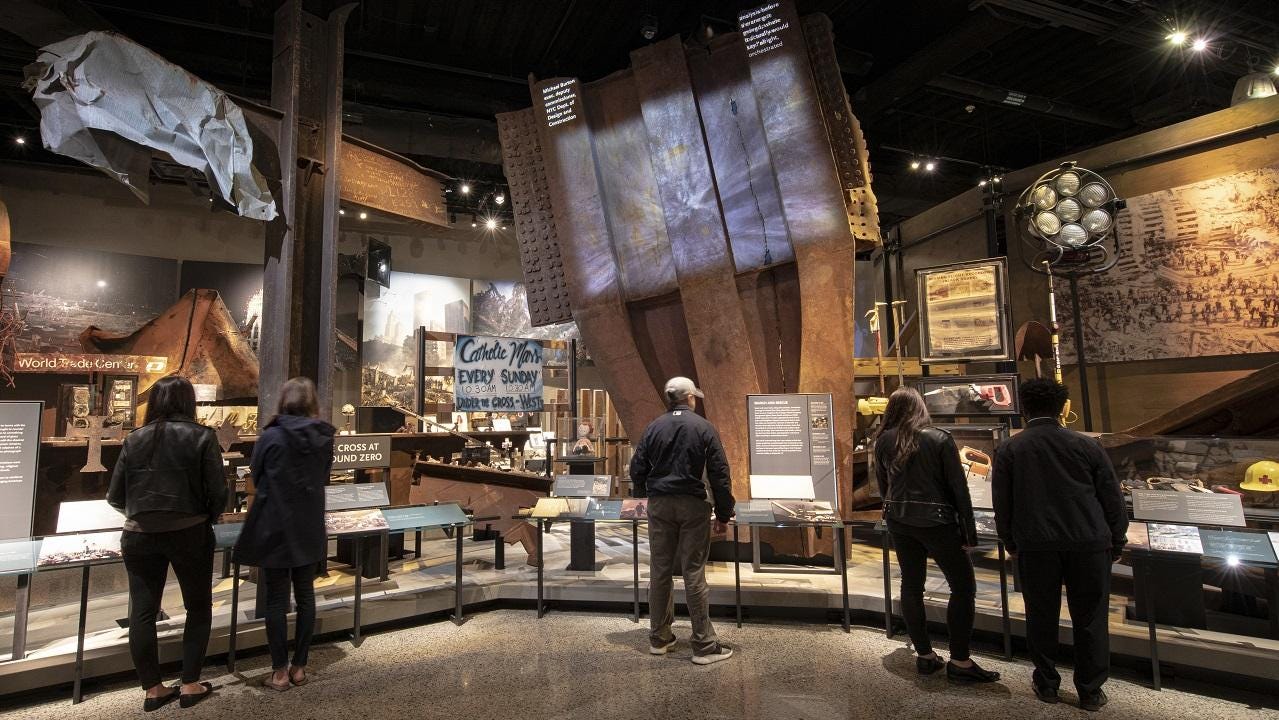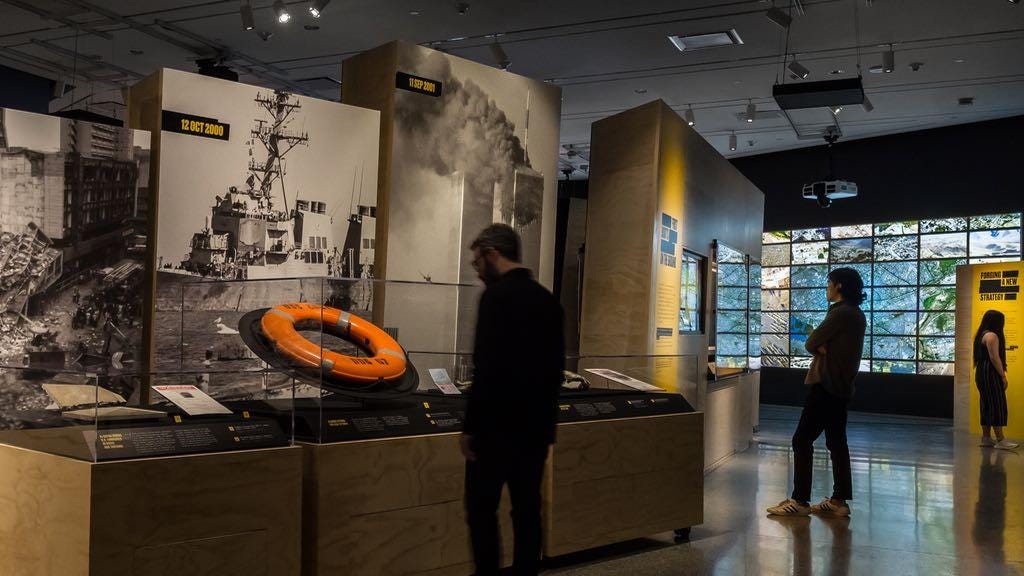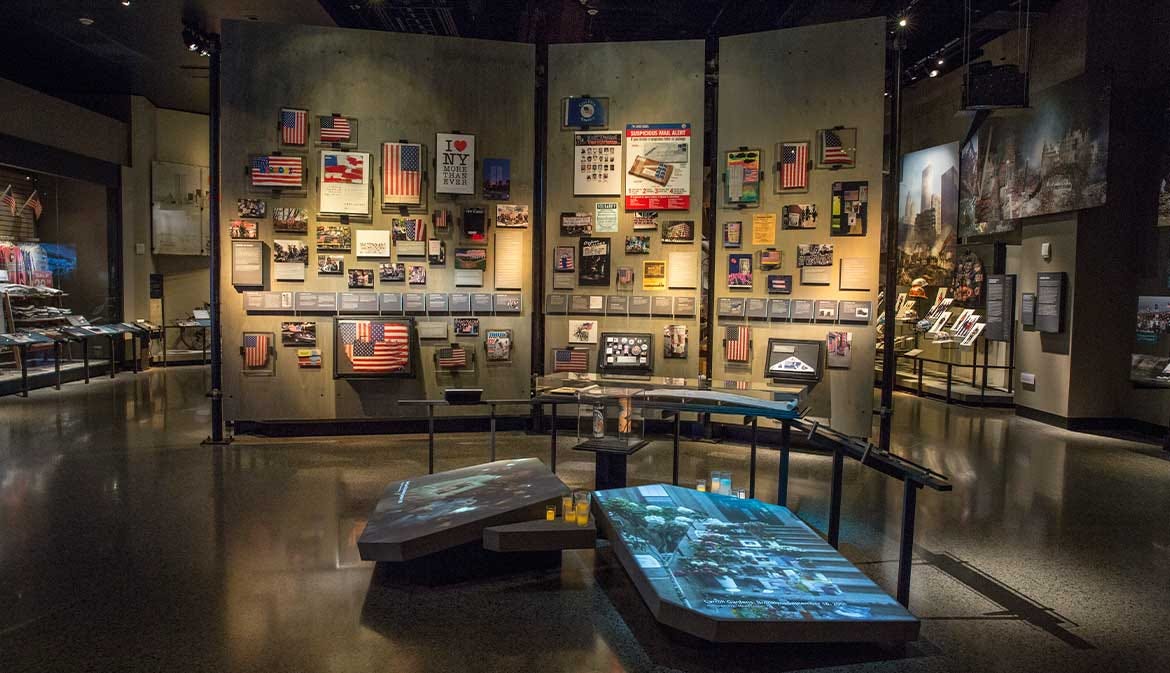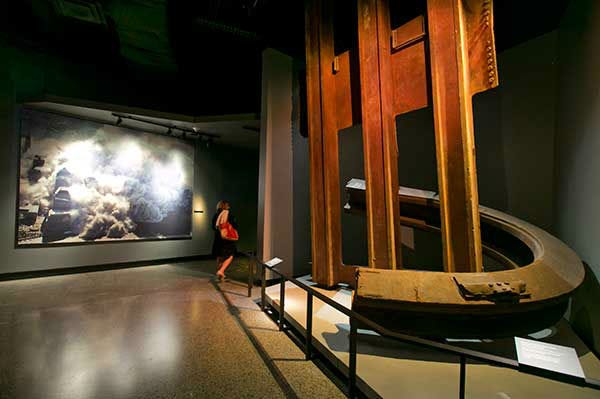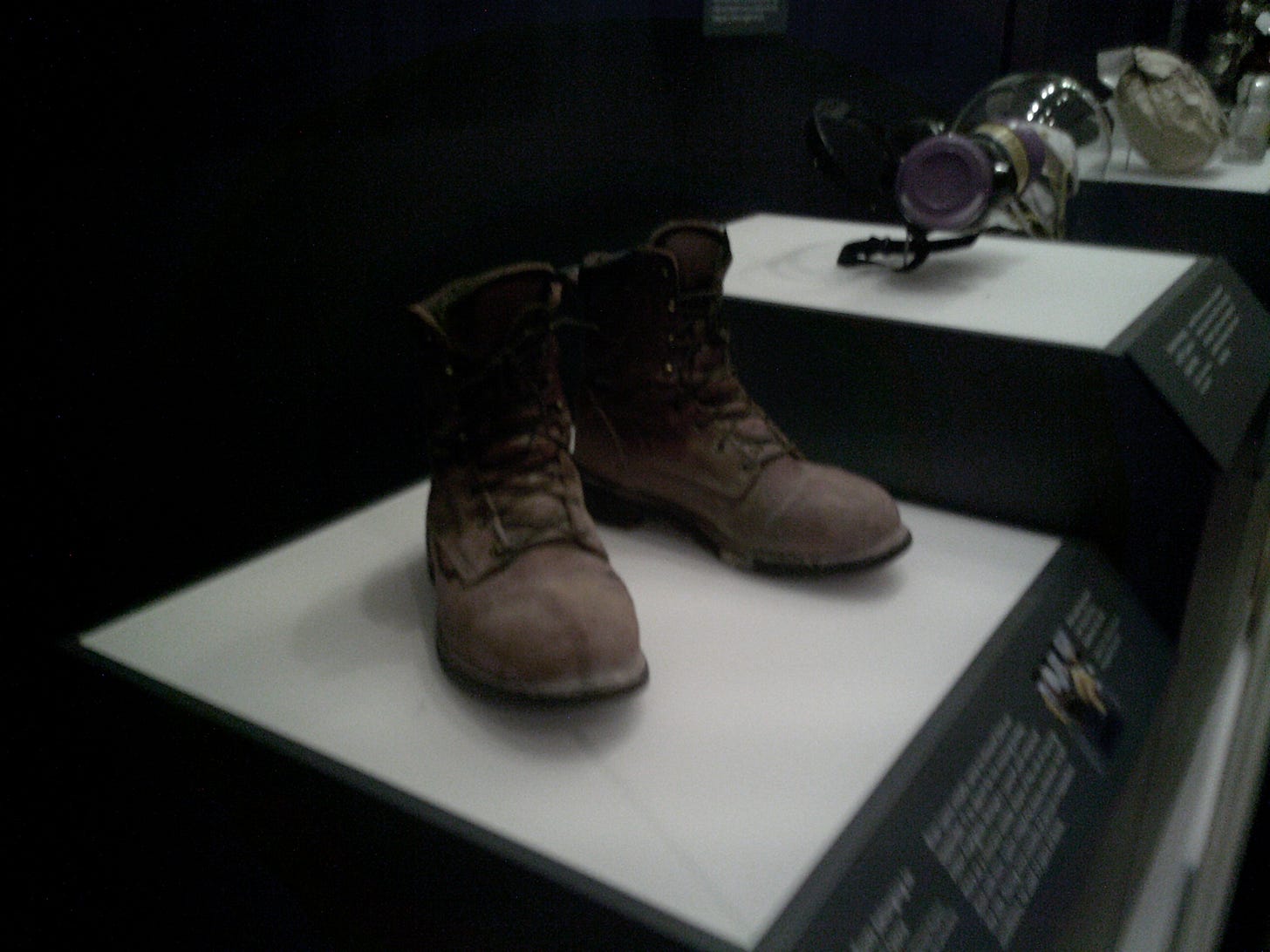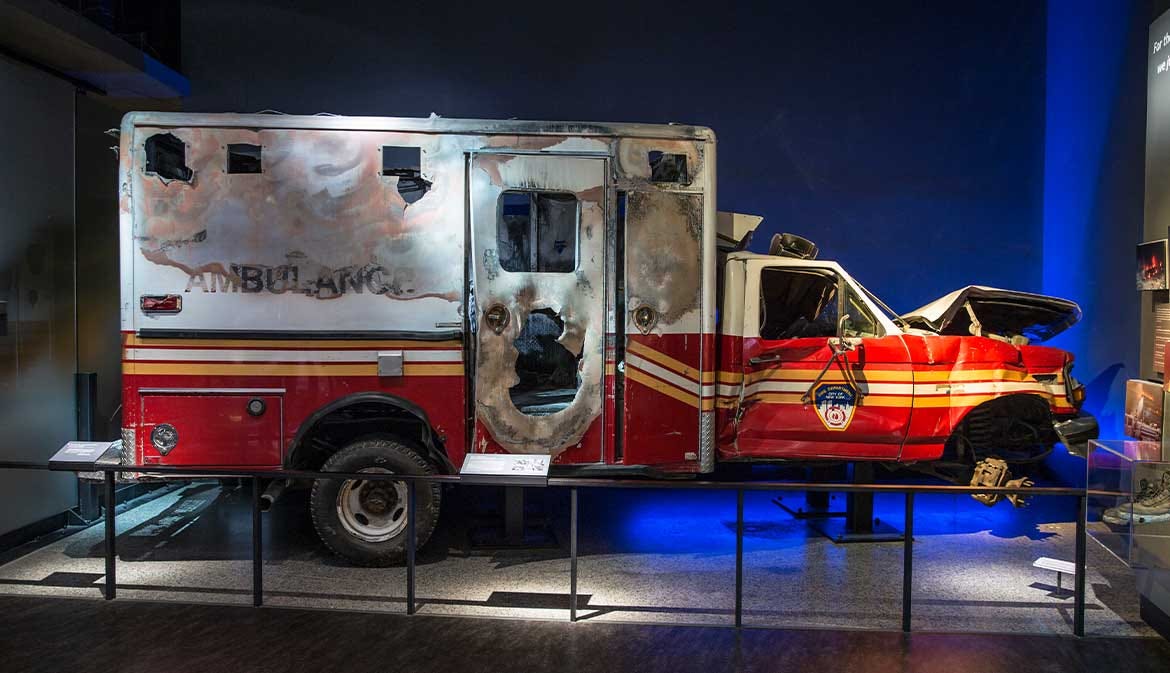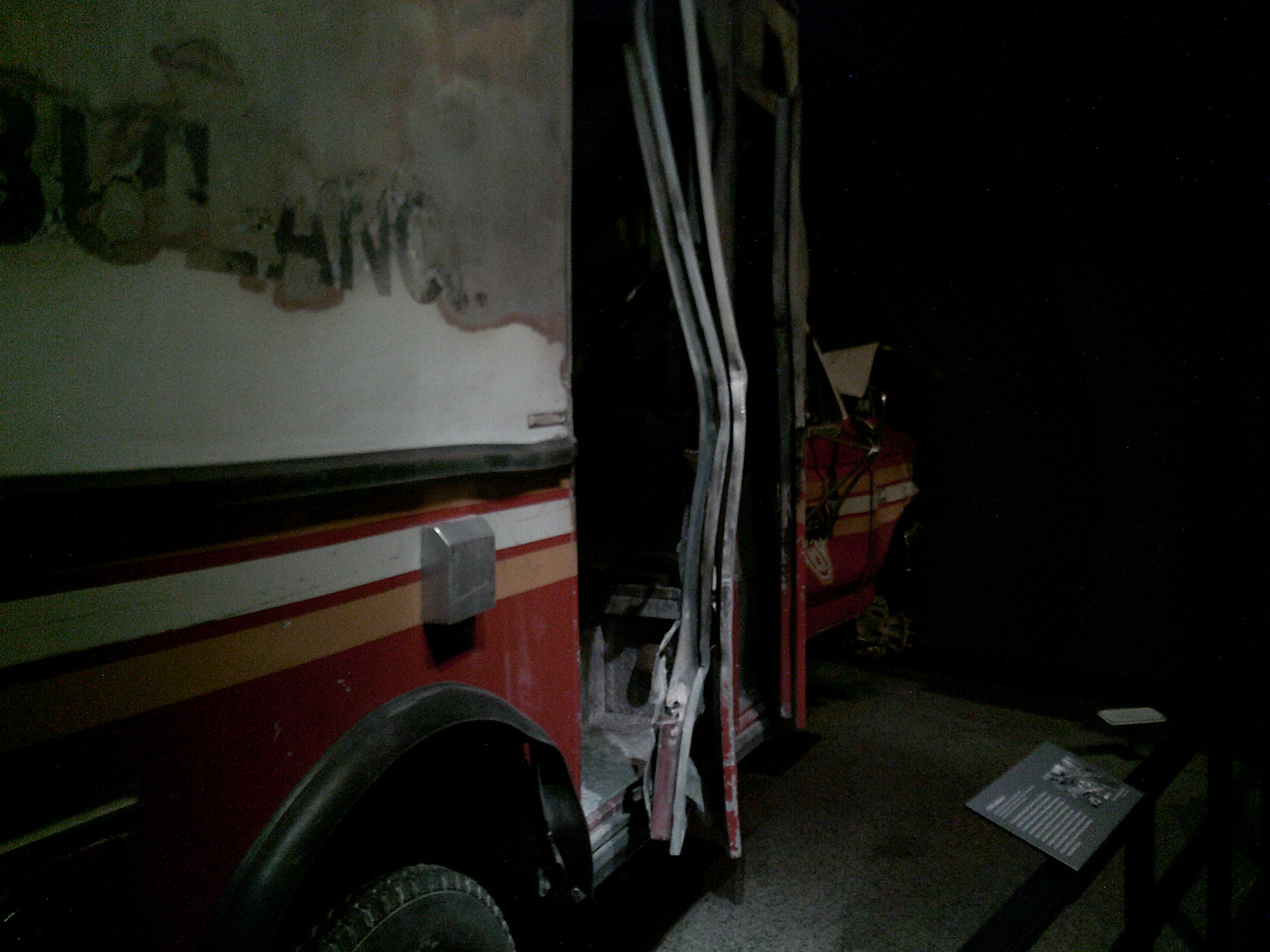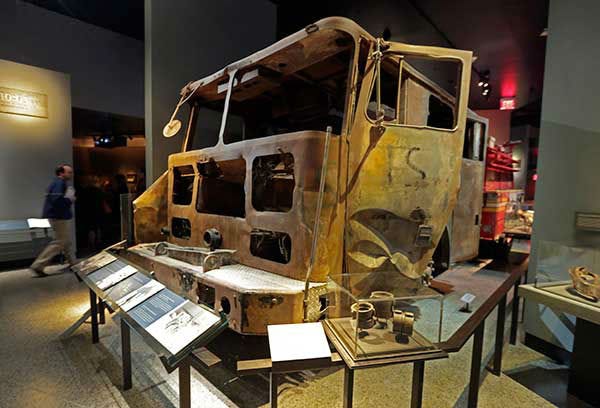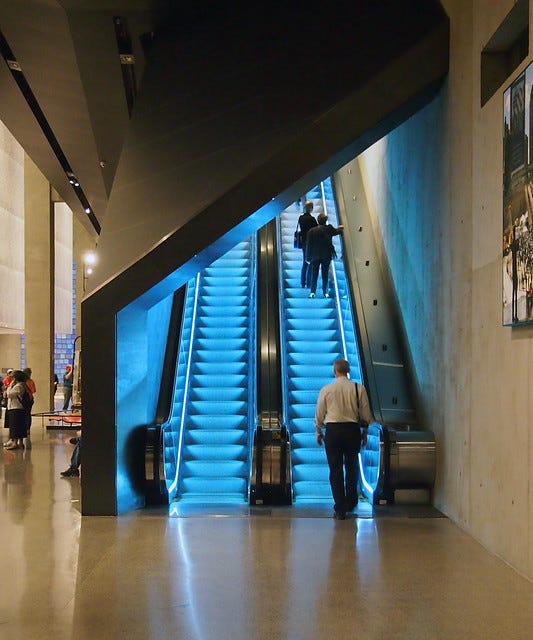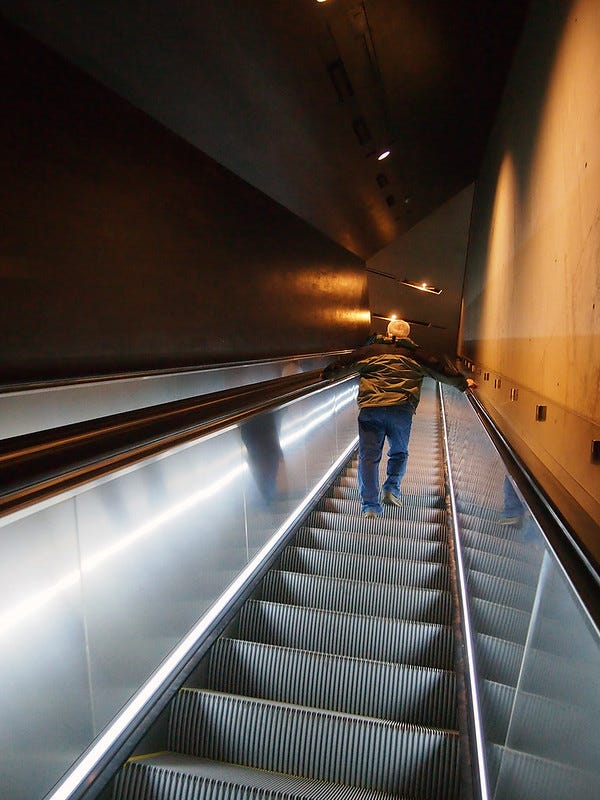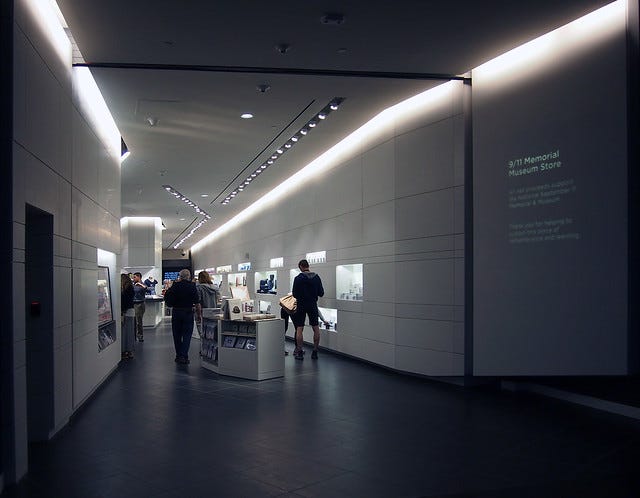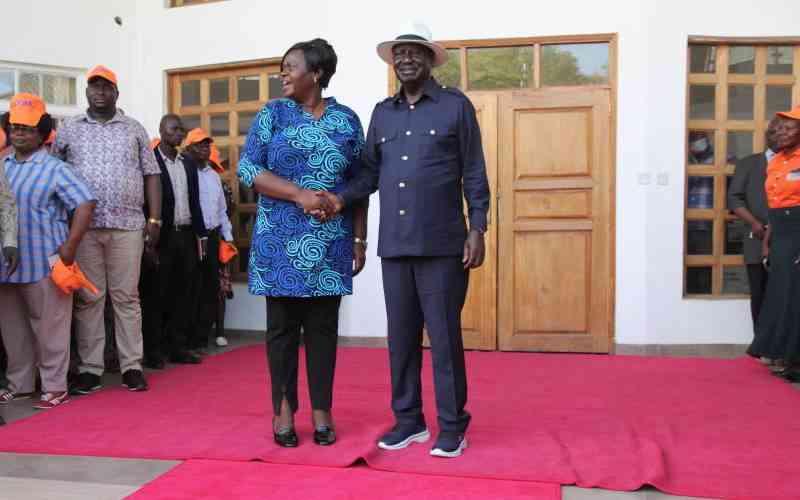This is the third and final part of this series on the 9/11 Memorial Museum. In the first two parts, I guided readers from the memorial pools above ground, through the museum pavilion, down into the deceptive and disorientating depths of the main museum.
Readers are now invited to join me in the conclusion of our tour of the museum, which mostly revolves around the North Tower footprint.
By the end of Part 2, we had reached the Center Passage of the museum, which runs along the south side of the North Tower footprint. There, we encountered Ladder 3 and a remnant of the antenna from the North Tower.
Next to Ladder 3 is a giant motor that was used to power one of 20 shuttle elevators in each tower that took people quickly from ground level up to the sky lobby transfer points.
In total, each tower had 99 elevators, including freight, local, and high-speed express cars (to the South Tower Observation Deck and the Windows of the World restaurant in the North Tower).
The Twin Towers were the first skyscrapers to have both local and express elevators. The motors, measuring 8 feet by 5 feet and weighing some 10,000 pounds, were the biggest in the world when they were first installed, and could move people through the building at 1,600 feet per minute.
The decision to make an elevator motor one of the first large pieces of debris encountered by visitors was presumably about what museum director Alice Greenwald called “emotional safety.” Though a large and impressive object in its own right, conveying the sense of scale involved in the Twin Towers, it is also a relatively banal object. Visitors will not know much about it, nor are they told very much by the information provided by the museum.
The lack of elevator cables attached to it, however, hints at a much darker legacy.
An investigation by USA Today found that at least 200 people died inside elevators in the Twin Towers:
Sixty-four of the twin towers’ 198 elevators had cables that ran through the floors devastated by the hijacked hijacked planes, and the cables were likely destroyed.
Forty-eight of these 64 elevators had no known survivors […]
The loss of life was almost complete inside the south tower’s 10 giant express elevators, which were shuttling evacuees from the 78th floor to the ground floor after the north tower was hit. Only four people survived.
[….]
The express elevators in the north tower had eight survivors in two elevators. In the other eight express elevators, nobody is known to have lived.
On the other hand, a large number of people in the South Tower were able to escape by elevator during the 17 minutes between the two “plane” impacts. After the second impact, some 60 elevator mechanics who had assembled inside the South Tower lobby fled the scene.
The motor room on the 78th of the South Tower is thought to have saved many lives, because the heavy metal equipment inside it, including elevator motors, prevented whatever hit the building from damaging one of three stairwells, allowing occupants to evacuate down it. In the North Tower, in contrast, all the stairwells above the 91st floor were cut off.
Because the elevator shafts were not the primary means of evacuation (and indeed became conduits for fire and smoke), they do not feature in the NIST reports. Most people who escaped did so via the stairwells.
Therefore, it is a risky business drawing attention to the elevators via a 10,000-pound elevator motor, if one is willing to tell the whole story. Instead, the museum distracts visitors with the story of John Menville, who helped install the elevators in 1969 and serviced them for the next 32 years.
Compared to the elevator motor, other, “emotionally safer” options (i.e., not involving life and death) were available. For example, two giant Freon tanks, forming part of the largest air conditioning system in the United States, were located deep underground and were recovered almost completely intact, with only one leak from one of the tanks, according to OSHA (2002, p. 21).
Source: osha.gov
However, the intact Freon tanks give the lie to the official “collapse” narrative, as well as the mainstream alternative narrative of “molten metal” and an “underground inferno” that would have caused the tanks to leak or explode.
The next “found object,” so to speak, which brings visitors into the Foundation Hall, is the so-called “horseshoe beam.”
This, surely, ranks among most the remarkable pieces of steel recovered from the debris at Ground Zero. Here it is before it was placed in the 9/11 Memorial Museum:
[Source: Telegraph]
And here it is in the museum:
Source: wendyperrin.com
Note that it has been placed such that the fractured part is prominent. It is smaller than I had imagined.
The mystery of the horseshoe beam is how it ended up that way, especially the smooth curve around the middle. The explanation on the accompanying sign in the museum is that this multi-ton beam, said to have come from between Floors 30 and 31 of the South Tower, was subjected to “extreme stresses.”
What stresses, exactly? We know that there was no “pancake collapse,” so what caused the beam to bend right round upon itself?
Ordinarily, structural steel is very hard to bend without heating it to approximately 540 degrees Celsius or using a specialist technique known as cold forming. Neither method was involved in the destruction of the Twin Towers.
Dr. Judy Wood, in Chapter 17 of her book, proposes that the “Tesla-Hutchison effect,” named after experiments carried out by scientist John Hutchison, may have been involved.
Source: drjudywood.com
Nevertheless, the outer bend of the horseshoe beam did fracture, and only one or two of the beams recovered from the wreckage appear to have bent in this way. Should we not expect to have seen more such beams if the Hutchison effect was acting on the whole of the Twin Towers?
For me, the horseshoe beam leaves more questions than answers.
Considering the sheer volume of the Foundation Hall (the largest open space in the museum), it is remarkably empty. There is the slurry wall on one side, the North Tower footprint on the other, and not much in between, apart from benches to sit on, some artefacts in glass containers, and the so-called “Last Column” removed from Ground Zero during excavation.
Source: fastcompany.com
The “Reflecting Absence” theme (the title of Michael Arad’s above-ground 9/11 Memorial) only goes so far in legitimizing wide empty expanses. Now that we have pressed deep into the 9/11 Memorial Museum, and have begun to encounter some major pieces of empirical evidence (Ladder 3, the antenna remnant, the elevator motor, and the horseshoe beam), it is reasonable to expect more such evidence.
Instead, we get this.
No sooner has the museum finally begun to feel serious about primary empirical evidence, than a single brick is presented as evidence that Osama bin Laden was the mastermind of the “9/11” attacks. It reads as deliberate mockery, but at least it provides some light relief for those who have properly educated themselves about those attacks.
Alongside the diagonal wall that cuts off the slurry wall, I was surprised to find an exhibition about the ongoing adverse health effects caused by the toxic dust that covered the whole of lower Manhattan (and beyond) following the destruction of the Twin Towers.
It had been known for years that the dust had caused disproportionately high levels of thyroid cancers and other diseases among first responders, and that the Environmental Protection Agency had lied at the time that the air was safe to breathe. I was unaware that there had been any official recognition of this, however.
The “Dust” exhibition points the finger at the EPA and states explicitly that
The museum website provides some shocking statistics in relation to the toxic dust:
Source: 9/11memorial.org
Whoever destroyed the WTC complex must have known that illnesses caused by the toxic dust would be an inevitable outcome. But they did it anyway.
Much attention is given to the 2,983 lives lost on September 11, 2001, and rightly so, but we should not forget that the act of war that took place that day physically harmed over 400,000 more people, causing cancers in 44,000 of them.
The World Trade Center (WTC) Health Program provides free medical monitoring and treatment to those directly affected by the attacks. Established by the James Zadroga 9/11 Health and Compensation Act (2010), it was reauthorized in 2015 until 2090.
In 2019, the 9/11 Victim Compensation Fund was also extended until 2090 and has so far paid out the following average sums:
Unfortunately, it stands to reason that families in receipt of such large sums of money will be unlikely to question the official version of events. They may even be legally bound not to.
For the historical record, a friend of mine who was living in mid Manhattan at the time kept a diary. Here are the relevant passages, reproduced with his permission:
Thursday, September 13, 2001:
Egad, now I’m sick!Saturday, September 15, 2001:
Still sick but slowly getting better. Here’s a summary of what’s been going on. On Wednesday evening [i.e., on 9/12/2001], the wind shifted and awful-smelling smoke from lower Manhattan got blown uptown. . . . [T]he smoke plus my lack of sleep and generally high emotional stress level combined to give me flu-like symptoms (which, I gather, others have likewise experienced — including [my friend] Alexis — although to a lesser degree). . . . [Y]es, I called in “sick” [for work] for Friday [i.e., 11/14/2021].Friday, September 21, 2001:
Here’s some catching up . . . . On Sunday the 16th, I was feeling well enough to do a light aerobic workout at the gym. . . . On the night of Monday the 17th, [running an errand], I still wasn’t feeling completely well.
He adds in his email to me:
Heaven only knows what constituted its full spectrum of components. But I was mindful of the rather chilling fact that — to some degree — I was probably inhaling particles of deceased human bodies.
My route along the Center Passage and the Foundation Hall led me to the North Tower Excavation, which runs along the north side of the North Tower footprint. It means that visitors then have to traverse the east side of the footprint, even though there is nothing to see there. I have marked my route in blue.
The North Tower Excavation route is a dull affair, although it does provide a sense of the distance from the outer box column imprints to the bedrock, at least for visitors willing to crane their necks back against the direction of travel.
Source: themaritimeexplorer.ca
The fact that everyone else around me was walking in the same direction suggested to me that the large majority of visitors end up proceeding clockwise around the North Tower footprint. Indeed, the design of the museum makes this highly likely.
Is there any occult significance in the fact that visitors circumnavigate the North Tower footprint, which, from above, appears as an inverted black cuboid?
Source: Google Maps
One is reminded of the Kaaba, although the direction of travel is clockwise in the museum rather than anti-clockwise.
Source: Al Jazeera
Below ground, the foamed aluminum paneling creates the impression of two giant cuboids, as seen below in the case of the South Tower footprint.
In the case of the North Tower footprint, the paneling forms a near-complete structure, although one corner is chopped off by the PATH trains at the bottom.
Remember, though, that the memorial pool is only 176 feet wide, compared to 211 feet and 10 inches for the cuboid structure. This means that an 18-foot-wide strip separates the perimeter of the pool from the perimeter of the cuboid. Therefore, it may still be possible that visitors are going clean around the perimeter of the memorial pool, 70 feet below ground.
Again, in that respect, it is hard not to be reminded of the Kaaba.
Source: Focus Online
This begs the question of what exactly the foamed aluminum paneling is concealing. Imagine the Kaaba with a featureless grey wall constructed 18 feet around its edges, reaching down to just above the heads of the pilgrims. Visitors to the 9/11 Memorial Museum only get to see the grey wall, not what is behind it.
Granted, at the bottom of the North Tower footprint is the Historical Exhibition, around which visitors may wander. But, given that the lower catch basin of the memorial pool extends 50 feet below ground, and that the bedrock is 70 feet below ground, the Historical Exhibition cannot reach any higher than 20 feet up, at least not in the center.
The memorial pool drops down 30 feet before the water runs into the lower catch basin. Assuming that the Historical Exhibition is no higher than 20 feet at any point (supporting evidence is needed here), then there is a 20-foot high space surrounding the lower catch basin that is unaccounted for.
What is the area of that hidden space? Let us do some calculations.
I have been unable to find the width of the lower catch basin, but it can be estimated visually. For example, the ratio of the lengths of the two arrows I have drawn below is, ironically, 9:11. This means that the lower catch basin is 9/31 the width of the memorial pool (176 feet), so approximately 51 feet. Its area, therefore, is ca. 2,601 square feet.
Source: Google Maps
The aluminum foamed paneling is 211 feet and 10 inches wide. This means that the area it contains is approximately 44,872 square feet. If we subtract the area of the lower catch basin from that, we are left with 42,271 square feet. That is the equivalent of 3,927 square meters, or 0.97 of an acre.
To be clear, a space that is 20 feet high, covering almost an acre, is contained with the 9/11 Memorial Museum, yet the public has no idea what is in it, or that it even exists. Meanwhile, millions of visitors a year move clockwise around that space at a lower level. There are grounds here to suspect that something esoteric is going on.
Beneath the foamed aluminum paneling lie thick concrete walls. It is possible that there is a massive building in its own right surrounding the lower catch basin.
The Foundation Hall during construction. Source: 911memorial.org
The Foundation Hall after construction. Source: fastcompany.com
We know that the space around the lower catch basins can be accessed, because there is a door in the center of each one. Cleaning and maintenance equipment will be part of what is down there, but only a small part.
How is the space surrounding the lower catch basin accessed? That much I have not been able to work out.
The only thing I can think of is that access is gained via the PATH mezzanine on basement level B3. I wish I had visited there now. Perhaps readers in NYC could investigate and send me some photographs?
New York Times
Having circled the North Tower footprint, visitors finally enter the Historical Exhibition, which was designed by Layman Designs.
If most visitors, as I suspect, follow the same route as I did, then entry into the Historical Exhibition is delayed until the final possible moment. It is as though the museum designer, Davis Brody Bond, wanted to keep historical evidence from the public for as long as possible.
After all this time walking around the museum, the primary empirical evidence witnessed so far in terms of the Twin Tower’s destruction has been minimal, namely: four types of beam (plane impact site, the Last Column, the twisted steel at the end of the Tribute Walk, and the horseshoe beam), plus Ladder 3, the antenna fragment, the elevator motor — and little else besides.
In contrast, there is an overload of evidence in the Historical Exhibition. According to the museum website, the museum’s permanent collection houses “82,000+ artifacts that document the fate of victims, survivors, and responders.” The large majority of those artefacts are contained within the Historical Exhibition.
It is far too much to take in at once, especially having traipsed through the rest of the museum for a good hour or so, thereby becoming disoriented and fatigued. Again, that is by design in my view. Even I, an avid student of “9/11” determined to see primary evidence with my own eyes, can barely remember a small fraction of what I saw in the Historical Exhibition.
As noted on the museum website, the Historical Exhibition is divided into three parts: “Events of the Day,” “Before 9/11,” and “After 9/11.” Only the first of these is amenable to scientific analysis based on primary observable evidence; the others are just about narrative.
Not only do the “events of the day” constitute only one third of the exhibition space, but they also come first, against chronological order. After the relative uneventfulness of what has come before in the museum, they have a “shock and awe” effect all of their own.
I recall suffering a sense of profound disorientation as I entered the Historical Exhibition. Look at the path of the arrows below. Once caught up in this one-way system, visitors are swept one way then another.
The blue spots mark potential early exit points for those feeling “emotionally unsafe,” offering repeated opportunities not to look at evidence.
For me, the Historical Exhibition felt like an unpleasant, overcrowded battle to reach the end, rather than a proper opportunity to consider the evidence on display.
Photography is banned in the Historical Exhibition, meaning that visitors are not allowed to take photographs that can be studied later or uploaded online. The justifiable prohibition on photography beneath the South Tower for In Memoriam suddenly started to feel like behavioral conditioning. Why should there be a ban on photographing historical evidence?
Despite the ban on photography in the Historical Exhibition, official images are available online. Below are some examples.
Steel from floors 97 and 98 of the North Tower in the foreground. Source: abc7ny.com
Source: Cumming Group
Source: today.com
Source: today.com
Source: 911families.org
Source: 911memorial.org
These images go some way to showing how “busy” the museum suddenly becomes in terms of evidence, following large expanses containing relatively little evidence. Some also show the darkness and shadows pervading the Historical Exhibition.
It is sometimes said that utilizing the Twin Towers’ ruins in the 9/11 Memorial Museum amounts to the “aestheticization of murder.” I have a certain sympathy with that position when one looks, for instance, at the use of the trident in the image above as a screen onto which to project a video. What function does the trident serve, other than an aesthetic one?
The “cross” to the left of the trident became famous at Ground Zero as a Christian symbol, but it tells us little, if anything about how the Twin Towers were destroyed.
Certain sections of the Historical Exhibition are pure propaganda.
For example, the section titled “Revealed: The Hunt For Bin Laden” promotes the official narrative that Osama bin Laden was not only responsible for the “9/11” attacks, but that he then managed to evade the world’s most advanced surveillance dragnet for over a decade until his reported capture in 2011.
Source: 911memorial.org
Forgotten here is that
Flag worship propaganda is evident in multiple places within the museum, including the Historical Exhibition.
Source: Cumming Group
Despite reasons to doubt that AA11 struck the North Tower (see the research of Mark Conlon), a fragment of fuselage is presented in the museum as belonging to that flight.
Source: 911memorial.org
Although the Historical Exhibition is geared to promoting the official narrative, a few items did stand out to me.
For example, the beam below was apparently “bent into a horseshoe shape” in even cleaner fashion than the “horseshoe beam” in the Foundation Hall. What caused this to happen?
Source: abc7ny.com
There are two examples of first responders’ boots having evidently not not had their soles “melted,” as per disinformation regarding temperatures on the pile.
There is a “toasted” ambulance which suffered apparent “burn” marks to its upper rear section, a hole in its side, loss of its front wheels, and damage to its hood. What explains this peculiar damage pattern?
Source: Cumming Group
The door of the ambulance appears to have warped outwards. Did a projectile pass clean through the ambulance, or does something else explain the warping?
The remains of NYFD Engine Company 21 can be seen, with the front end apparently burned out and its lights and glass missing. Again, what exactly caused this to happen?
Source: abcny7.com.
One item that I wanted to see but did not is the Bible that was somehow fused into steel and concrete without burning — yet another anomaly requiring explanation.
Source: churchpop.com
There were probably other items of interest, but having been suddenly overloaded with information, disoriented by the layout of the Historical Exhibition, and swept along by the crowd, it was not possible to study the evidence properly. Which I dare say is precisely the point.
Visitors exit the lower levels on two long escalators that are hidden by a wall on the Center Passage.
Source: Archidose
The escalators are easy to miss, as I did when I walked straight past them on my way from Ladder 3 to the horseshoe beam. Consequently, in the back of my mind, I became increasingly nagged by the question of how I was going to get out. Consciously, of course, I knew there would be an exit, but the museum seems designed to play on all manner of semi- or unconscious fears.
Archidose refers to the escalators as “illumined,” and 911families.org refers to the ascent out of darkness in terms of the “classic route of religious ritual and regeneration, bringing images of the tomb and the seedbed to mind.”
I personally found the long barren ascent to be unnerving.
Source: Archidose
Although I cannot find anything about the escalators’ significance on the museum website, I agree that a symbolic rebirth is intended — not in the Christian sense, but, rather, in keeping with the principles of mind control. Project Monarch, for instance, which apparently continued MKULTRA under a different guise, is said to have been named after the Monarch butterfly, with victims being “reborn” into a new personality, much as a butterfly emerges from its chrysalis.
With the unconscious programming of visitors’ minds complete, it is time for them to be released back into the world. To the extent that the programming has worked, they may later find themselves instinctively defending the official “9/11” narrative without necessarily knowing why. If around 2.25 million people visit the museum each year, then well over over 20 million people have unwittingly been through this process so far.
Rather tastelessly, visitors exit the museum through a gift shop. Somehow, remembering the dead and memorializing the events of September 11, 2001, ends with the opportunity to buy fridge magnets, necklaces, and other “9/11”-themed paraphernalia.
Source: Archidose
Like the PATH trains that plough straight through the South Tower footprint, the gift shop serves as a stark reminder that nothing on the site is truly sacred, and that commercial realities always prevail.
Again, this desacralization seems consistent with occult themes.
The 9/11 Memorial Museum was nothing like what I expected. Admittedly, I had not looked into it in detail before visiting, but I expected it to be more like a regular museum, i.e., mostly above ground, with plenty of primary empirical evidence to look at from the start.
Instead, the visitor experience involves:
In my opinion, the museum is not so much about memorializing the events of September 11, 2001, as it is about using known mind control techniques to manipulate visitors psychologically into believing the official narrative.
I knew before I entered that the museum’s primary function would be to support the official narrative of “9/11.” It did not surprise me to hear about a “pancake collapse” or to encounter a large section on Al Qaeda (which I walked straight through), for instance.
I was not prepared, however, for the gamut of mind control techniques deployed. For example, we see the use of shock, defamiliarization, trauma, confusion, and deception to render the mind susceptible to propaganda and programming.
Nor was I prepared for the occult aspects involving the underworld and reference to the Aeneid, circling a giant cuboid structure and its unknown contents, the desacralization of what should be a sacred space, and the theme of rebirth.
The implications are highly disturbing. Not only was “9/11” itself an assault on public consciousness — a Big Lie to legitimize ever-growing tyranny through the “War on Terror” — but the way in which “9/11” has been memorialized maintains that assault.
Extreme caution is warranted before consenting to enter.
